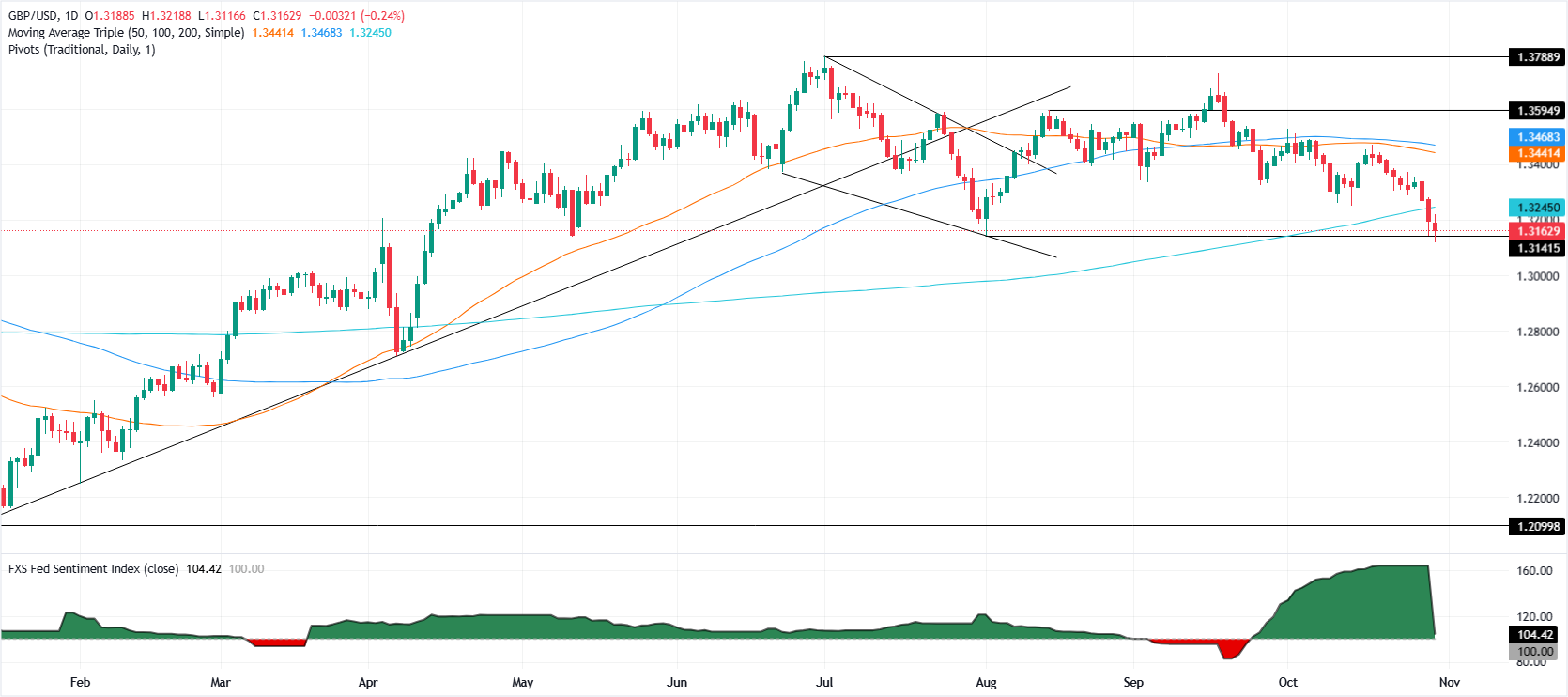GBP/USD sinks below 1.32 as Powell’s “hawkish cut” strengthens Dollar
- GBP/USD falls for third straight day, down 0.25% after Fed signals December cut remains uncertain.
- Powell warns inflation risks stay tilted higher as Fed ends balance sheet runoff on December 1.
- UK fiscal uncertainty pressures Sterling amid reports Reeves may adjust windfall and income taxes.
GBP/USD extended its losses for the third straight day, dives over 0.25% as traders push the exchange rate below the 1.3200 handle, following the Fed “hawkish” rate cut as the Chairman Jerome Powell poured cold water of a reduction in the December’s meeting. At the time of writing, GBP/USD trades at 1.3160 after hitting a daily high of 1.3218.
Pound pressured ahead of next week’s BoE decision and UK fiscal plans
On Wednesday, the Fed cut rates to 3.75%-4% amid the lack of economic data due to the US government shutdown, entering its thirtieth day. The decision was not unanimous, with Fed Governor Stephen Miran opting for a 50-bps cut, while the Kansas City Fed President Jeffrey Schmid voted to hold rates unchanged.
Also, the US central bank announced the end of Quantitative Easing (QE) on December 1. In the press conference, Powell said that the balance of risks are tilted to the upside on inflation and to the downside on the jobs market and added that there were constructive discussions at the meeting, regarding the December’s decision.
Powell made clear that a cut in December, is far from a sure thing, as he said, “a further reduction in the policy rate at the December meeting is not a foregone conclusion — far from it.”
Meanwhile, the Pound Sterling remains pressured as investors’ attention shifts to next week’s Banf of England (BoE) monetary policy decision, and the UK budget. The Financial Times revealed that UK Chancellor Reeves is looking at an early scraping of windfall tax on the UK oil and gas sector. The Telegraph said that Reeves is considering a 2 percent rise in income tax.
The light US schedule will feature Dallas Fed President Lorie Logan late today and on Friday. Atlanta’s Fed Raphael Bostic and Cleveland’s Beth Hammack will cross the wires on Friday at a research conference.
GBP/USD Price Forecast: Technical outlook
The technical picture shows the GBP/USD is bearishly biased after clearing the 200-day SMA at 1.3242, which opened the door to drop below 1.3200. A daily close below the 200-day SMA would cement the trend shift, exposing key support levels like the 1.3000 figure, followed by the April 8 low of 1.2708.
Conversely, if buyers reclaim 1.3200, the GBP/USD could consolidate within the 1.32/1.33 range in the near term.

Pound Sterling FAQs
The Pound Sterling (GBP) is the oldest currency in the world (886 AD) and the official currency of the United Kingdom. It is the fourth most traded unit for foreign exchange (FX) in the world, accounting for 12% of all transactions, averaging $630 billion a day, according to 2022 data. Its key trading pairs are GBP/USD, also known as ‘Cable’, which accounts for 11% of FX, GBP/JPY, or the ‘Dragon’ as it is known by traders (3%), and EUR/GBP (2%). The Pound Sterling is issued by the Bank of England (BoE).
The single most important factor influencing the value of the Pound Sterling is monetary policy decided by the Bank of England. The BoE bases its decisions on whether it has achieved its primary goal of “price stability” – a steady inflation rate of around 2%. Its primary tool for achieving this is the adjustment of interest rates. When inflation is too high, the BoE will try to rein it in by raising interest rates, making it more expensive for people and businesses to access credit. This is generally positive for GBP, as higher interest rates make the UK a more attractive place for global investors to park their money. When inflation falls too low it is a sign economic growth is slowing. In this scenario, the BoE will consider lowering interest rates to cheapen credit so businesses will borrow more to invest in growth-generating projects.
Data releases gauge the health of the economy and can impact the value of the Pound Sterling. Indicators such as GDP, Manufacturing and Services PMIs, and employment can all influence the direction of the GBP. A strong economy is good for Sterling. Not only does it attract more foreign investment but it may encourage the BoE to put up interest rates, which will directly strengthen GBP. Otherwise, if economic data is weak, the Pound Sterling is likely to fall.
Another significant data release for the Pound Sterling is the Trade Balance. This indicator measures the difference between what a country earns from its exports and what it spends on imports over a given period. If a country produces highly sought-after exports, its currency will benefit purely from the extra demand created from foreign buyers seeking to purchase these goods. Therefore, a positive net Trade Balance strengthens a currency and vice versa for a negative balance.

